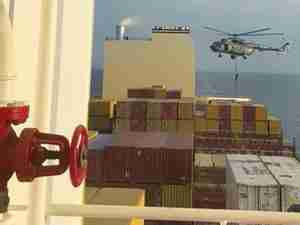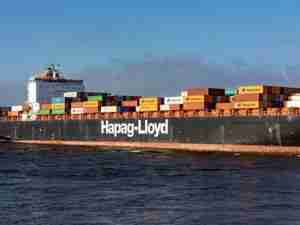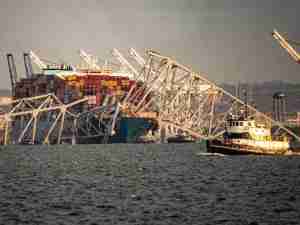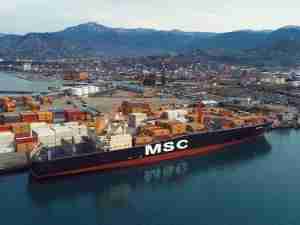 Largest mobile harbor crane in North America lifts prospects for Columbia River port
Largest mobile harbor crane in North America lifts prospects for Columbia River port
Vestas, the world's leading wind turbine manufacturer, officially named Port of Vancouver, USA as the exclusive port of entry with a multi-year contract for all of its wind energy projects in the Columbia River region on Sept. 8 at the port's crane commissioning ceremony. The new 3-year contract with Vestas guarantees heavy-lift project cargo business for the port's new crane, the largest mobile harbor crane in North America. 'We expect big numbers of turbines to come through this port,' announced Jens Soby, president of Vestas American Wind Technology Inc.
Capable of lifting 140 metric tons, the $3.2 million crane was commissioned by hoisting a load that was light in weight but heavy in symbolism. With US Congressman Brian Baird, and more than 200 dignitaries and waterfront workers looking on, crane operator, John Vea of International Longshore and Warehouse Union (ILWU) Local 4, raised an American flag into the air on the crane's 174-foot boom.
'Federal programs like the wind production tax credit have helped fuel the growth in wind farm projects. I commend the Port of Vancouver for its investment in this growing clean industry,' said Congressman Baird. 'The new crane will benefit local workers, our regional economy, and our country's future as we recognize the value of renewable energy and embrace the technology.'
Congressman Baird is co-sponsoring legislation to extend the wind production tax credit to 2011 fostering the growth of wind energy in the Northwest. Increasing costs for petroleum fuels, combined with the wind energy Protection Tax Credit, has increased the profitability of wind energy development. The tax credit, which was extended last year through the end of 2007, provides a 1.9 cent/kilowatt hour tax credit for electricity generated with wind turbines over the first ten years of a project's operation. It has been a critical factor in making the development of new wind farms financially feasible.
The crane was purchased, in part, to unload the gigantic generators, blades and hubs for Pacific Northwest wind farms, a rapidly expanding source of alternative energy in the United States. Port of Vancouver is currently the port of entry for wind turbines heading to the Wild Horse Wind Energy facility, owned by Puget Sound Energy (PSE), near Ellensburg, WA. PSE has set a goal to have 10% of its customers' total electricity supplied through renewable energy resources by 2015.
The LHM 500S crane, from Austrian crane manufacturer Liebherr, is capable of hoisting 140 metric tons up to 60-foot outreach and 100 metric tons at 100-foot outreach. With 80 wheels on 20-axle sets, it can turn on a dime in any direction. These features improve the efficiency of cargo operations and minimize multiple moves; ultimately, saving port customers time and labor costs.
The crane weighs close to 500 tons, has a tower height of 116.5 feet, and a boom length of 174 feet. Powered by a 12-cylinder MAN diesel engine, it is biodiesel-compatible, in compliance with the port's policy to use alternative fuels in its equipment fleet.
'This heavy lift crane brings a whole new dimension for cargo handling in the Columbia River, positioning Vancouver as a premier project cargo port,' said Larry Paulson, Port Executive Director. "We already handle several large wind turbine projects, and this additional capability will open up new markets for the region to handle heavy or oversize equipment, generators, and components for large scale projects in the energy and transportation industries."
The port will utilize the crane to complete a six-month project handling over 1,000 components for the 127-unit Wild Horse wind farm. The 69-ton nacelles, 21-ton hubs and 129-foot-long blades all require special handling for off-loading and transfer to customized trucks that will carry them to the wind farm site. Scheduled









